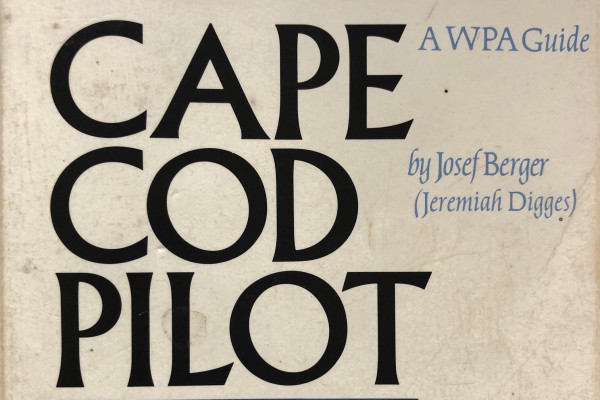
The book jacket featured a Ross Moffett painting, “Truro lobsterman.” (This is not the original publication, republished by Northeastern University Press in 1985 )
By Seth Rolbein
Only the Great Depression of the 1930s rivals this moment for damage done to our livelihoods, our sense of security, our communities.
During the darkest times of that Depression, 1934, a man moved to Cape Cod with his wife and small daughter. At 31 years old he had already been a young reporter for the Kansas City Star, then lived in New York City for 10 years trying to get paid for writing magazine articles, kids’ books, you name it. He moved to the Cape as one of an influx of creative souls who decided to make Provincetown home – perhaps he figured it would be better to be destitute here than there.
That he nearly was, until one year later when he caught on with the Federal Writer’s Project, part of the famous WPA, the Works Progress Administration which was the government’s flagship effort to put people back to work. It was the “stimulus package” of that time, and included hiring people to do everything from building roads and bridges to cutting trails in national parks to writing books.
His given name was Josef Berger, and he spent the next few years getting to know Cape Cod very well. He took a pseudonym, Jeremiah Digges, maybe because at that time having a German name was no advantage. In 1937 the WPA published his book, “Cape Cod Pilot,” a combination guidebook, travelogue, and history, full of anecdotes and observations, great reporting and tall tales, by turns hilarious and deep, whimsical and factual, divided into chapters for every Cape town. Digges moved through the villages and through time, and his book was a big success, selling out the first run (only 5000 books, but still), selling out a second run (only 5000 more, admittedly), winning him a Guggenheim fellowship, and leaving behind a tome that rivals the work of Thoreau, Henry Kittredge, and Shebnah Rich for the title of best-ever Cape Cod nonfiction.
Not surprisingly, fishing and fishermen show up often in “Pilot,” and Digges went deeper into the fisheries in 1941 with a book called “In Great Waters.” The subtitle says it all; “The Story of Portuguese Fishermen.”
By then Digges had left the Cape, moving to Washington DC where he wrote speeches for the likes of then-Attorney General Francis Biddle (who also had strong Cape Cod connections) and even President Roosevelt. He traveled to Europe working on reparations issues after the war, came back to a stint writing daytime television scripts, and then settled into speechwriting for the March of Dimes before he died in New York City in 1971.
It is Digges’ Cape Cod writing that has survived, made possible by public support in the form of a salary offered via a federal stimulus program, outlasting that other Great Depression. And so it seems appropriate to offer an excerpt, fishing related. No short vignette does justice to the breadth and depth of “Cape Cod Pilot,” but still, it’s a fun read and comes from his chapter based in Falmouth:
Down at the waterfront, where the Nantucket steamer docks, you may find a few of the “Nomansisland fleet” of swordfishermen tied up. These flingers of the lily-iron follow a hazardous trade. While modern whaling has gone into the use of bomb-lancing, with a forty thousand ton mothership at hand, the swordfisherman still goes out to his small craft, standing in the “pulpit” with iron in hand while his mates keep watch from the masthead. And if they are accomplished yarners, it is partly because they do not have to draw heavily on their imaginations.
Take Gasper Mano, for instance. A few years ago, sailing off the territorial limit near Scatterie Island, Gasper’s skipper made fast to a huge fellow, tossed over the buoy attached to the harpoon rope, and sent Gasper out in the dory to bring the fish aboard. Gasper rowed out and made the buoy-line fast to his dory. Suddenly the fish came to life – to very lively life, in fact – and before Gasper could get his oars into the rowlocks there came a tug that nearly spilled him out astern. Then away through the seas with the greatest of ease, the young man went flying in his dory, on what is known in whaling circles as a Nantucket sleigh-ride. On such occasions there is nothing for a conscientious young fisherman to do but sit and watch the vessel grow smaller and think of the long row back.
Gasper sat and thought until his vessel disappeared. On went the swordfish, at a twenty-five-mile clip. At last, just when they began to slow down, the Canadian Coast Guard Cutter Bay Hound hove in sight. Down she bore on Gasper Mano, and he and his fish were taken into custody on a charge of playing their little game in forbidden waters, within territorial limits. Gasper, after telling it to a judge, was finally released. The story of his adventure – if you still don’t believe it – is on the records of the court in Sydney, Nova Scotia.
